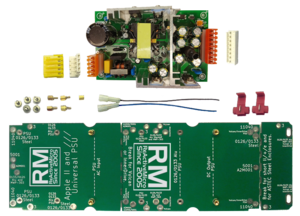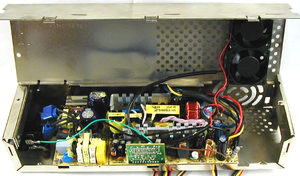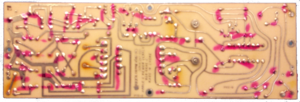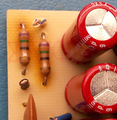Universal PSU Kit: Difference between revisions
No edit summary |
No edit summary |
||
| Line 1: | Line 1: | ||
[[Image:Universal_PSU_Kit_Main1.png|thumb|upright= | [[Image:Universal_PSU_Kit_Main1.png|thumb|upright=1|The Universal PSU Kit]] | ||
The Universal PSU Kit is a Power Supply replacement designed to be installed by the end user. It is designed to replace the old Power Supply PCB with a new, modern solution while reusing the old Power Supply Enclosure. | The Universal PSU Kit is a Power Supply replacement designed to be installed by the end user. It is designed to replace the old Power Supply PCB with a new, modern solution while reusing the old Power Supply Enclosure. | ||
| Line 45: | Line 45: | ||
== Project Progression: Universal PSU Kit == | == Project Progression: Universal PSU Kit == | ||
After some more research Henry learned that ATX was not a good solution for the Apple II. It poses several issues. For example the "IOmin" values are never met, and the +3.3v output is not used. Some ATX PSUs also have a +5v VSB output that isn't used in the Apple II. And most ATX units today don't have -5v anymore, so we are forced to make it. | |||
Not meeting the IOmin values can cause something as simple as reduced power or voltage regulation, or even the ATX PSU not turning on. It can also lead to things a lot worse such as wild swings in output voltages far beyond what is normal and the PSU overheating or burning up. Issues can and will be inconsistent and are affected by temperatures, humidly, how "clean" the AC input power or voltage is, and loads. An ATX PSU is NOT the right choice for an Apple II in ANY situation. | |||
An ATX PSU is not designed to operate with a load as low as the Apple II. The Apple II only requires about 15w of power. It's like a Buggy: Dependable, easy to repair, low cost, easy to understand and add to. The PSU it requires is only a small work animal, like mule or horse. In comparison, an ATX PSU starts at the low end of 150w and go up in to the thousands of Watts. They are designed to power much bigger power hungry and complex systems. The Buggy is perfect for a local trip to the corner store, and the Rocket is a better choice when trying to reach the Moon. It is always best to match the tool to the job. You don’t want to use a chain saw to widdle a toothpick. Nor do you want to use a pen knife to cut down a 200 year old oak tree. | |||
So Henry needed to find a PSU that had quad voltage output (-5v, -12v, +5v, and +12v), had the correct Amperages (-5v, -12v, +5v, and +12v) | |||
After a little | |||
<gallery class="center" widths=300px caption="Your Apple II Design Verses Connected To An ATX PSU"> | |||
File:Horse_and_Buggy.png|Your Apple II/III's Design | |||
File:Rocket.png|Your Apple II on ATX | |||
</gallery> | |||
== Capacitor Kits and Rebuilds == | |||
Some users have purchased and installed "Capacitor Kits" and even replaced some critical parts like Diodes. This is better of course, but sorry to say you still need a new PSU. | |||
At the the heart of the PSU is the Step Down Transformer. Did you replace this? We know you couldn't have since they don't make them anymore. And if you did, then it was old stock that also 30 years old. The problem here is the copper wires inside the Transformer are coated with a very thin insulating coating. After years of oxidation and wear of heating up and cooling down cracks form which leads to the Transformer shorting out and usually lots of smoke and even fire. Worse than this however is it can lead to the Transformer outputting voltages far in excess of what they should be. This is the primary cause of damage to motherboards and peripherals. Parts will be over-stressed due to the unregulated voltages output by a dying Transformer. If this doesn't lead to instant failure of an IC, then it will weaken it which leads to an early demise or intermittent issues. | |||
All the Capacitors do is help keep the output power "clean". They do little in the way of regulation or producing the voltages. Replacing the Capacitors is the same as replacing the tires on a car of the same age of your Apple without replacing the engine or transmission. The Capacitors don't do any of the "hard" work. All the other parts do and is why you will see burn marks on the PCB from parts over heating but never around the Capacitors. | |||
== Support == | |||
Revision as of 15:01, 4 September 2016

The Universal PSU Kit is a Power Supply replacement designed to be installed by the end user. It is designed to replace the old Power Supply PCB with a new, modern solution while reusing the old Power Supply Enclosure.
As the name implies, the Kit covers the Apple II, II+, IIe, IIgs, and Apple ///. It was conceived, created, and designed by Henry of ReActiveMicro and released for sale to the Apple II Community on April 25th, 2016. The project bears the "UM" Ultimate-Micro logo and technically was a collaborative effort with UltimateApple2.
When Do YOU Need A New Power Supply? Good question! Although the answer should be obvious. It is the original, 30+ year old PSU that came with the Apple? Then you need a new one. That simple. How much more do you want or expect from a piece of equipment that was only designed to last a few years at the most? Do you really believe that Apple designed the Power Supply to last 30+ years? Most people either don't realize the potential dangers of continuing to use an old PSU or are of the denialist mindset "If it ain't broke, don't fix it." Both can be equally damaging to your beloved Apple II.
Project Status: Complete. In production. Actively sold by ReActiveMicro and Ultimate-Micro.
Support: Post on the Discussion page (link above) or email ReActiveMicro Support.
History
When Henry from ReActiveMicro first returned to the Apple II he found several systems obtained had Power Supply issues or wouldn't power on. Some systems appeared to work but had very intermittent problems. This caused several issues with testing and projects.
Henry started by diagnosing most issues back to the Power Supply. These units were about 20 years old at the time, and were only designed to last 5 at the most. A lot of the parts responsible for voltage regulation were either dried out or had been over heated. Some capacitors even showed signs of being swollen. Any bulging top means that they are damaged, will not function properly, and should be replaced immediately.
During his research Henry found that all Apple Power Supplies were designed very poorly. Parts were always under sized for the job they were required to do. This led to many parts overheating. Some even get so hot as to discolor the fiberglass PCB (pictured right). Many Power Supplies exampled showed signs of extreme over-stressing. This isn't as much of an issue with lightly loaded systems, however those systems loaded with peripheral cards or high-drain devices may see more apparent issues or even Power Supply failures.
So Henry was faced with two options: Rebuild the 20+ year old Power Supply Unit (PSU), or find a replacement which could be mounted in the Apple II and Apple ///.
- Examples Of Overheated PCBs
-
Rear of common PCB damage.
-
Front of common PCB damage.
Project Progression: Rebuild
Henry first started by rebuilding old Apple II PSU boards in 2005. This however posed some issues since there were many variations of the PSU boards. Each board has at least 50 parts. Some parts are hard to access and remove. Other parts are so old they are no longer produced and need to be cross referenced with newer parts. And worst of all, most parts are under sized and need to have their ratings increased so they are no longer being over-stressed.
The time involved on a PSU PCB rebuild is in the range of 5 hours. Some of the replacement parts can also be costly and hard to find. The amount of time and effort needed to even rebuild 5 PSUs just didn't seem worth it after a while. A major issue remained however. The heart of the PSU still wasn't being replaced - the Step-down Transformer. This was the one part which is no longer produced. There is some New Old Stock (NOS) to be found, however it is not new and is still 20+ years old.
The problem here is the copper wires inside the Transformer are coated with a very thin insulating coating. After years of oxidation and wear of heating up and cooling down cracks form which leads to the Transformer shorting out and usually lots of smoke and even fire. Worse than this however is it can lead to the Transformer outputting voltages far in excess of what they should be. This is the primary cause of damage to motherboards and peripherals. Parts will be over-stressed due to the unregulated voltages output by a dying Transformer. If this doesn't lead to instant failure of an IC, then it will weaken it which leads to an early demise or intermittent issues. The Transformer doesn't need to fail for such issues as well. Many of the regulating Diodes can also fail and cause damage in the same way.
Project Progression: ATX PSU

In 2006 Henry changed his approach from repair to replacement. The new concept would be to be remove the old Apple PSU PCB and replace it with a new ATX PSU PCB.
Henry found a U2 size ATX Power Supply (now called Mini ITX) which came standard with the -12v and -5v outputs. Most Power Supplies no longer supply -5v, which the Apple II requires. This "U2" size was however a perfect fit for a replacement PSU PCB option. This approach however had some issues.
First, Henry would need to disassemble the ATX Power Supply and remove the ATX PCB. Next, the bare ATX PCB didn't mount to the Apple II Enclosure's mounting points. Apple's Enclosures don't have any standardized mounting points inside. These mounting points change from model to model. This forced Henry to modify the Apple PSU Enclosure - something he is against. He would need to remove or add standoffs in order to firmly secure the new ATX PCB inside the Enclosure. Lastly, connecting the Apple II DC Output Cable to the ATX PSU proved time consuming. In fact the whole upgrade procedure would take about 2 hours to complete. This coupled with the cost of a Server grade U2 ATX Power Supply proved an expensive option for most users.
After about a year of selling the ATX replacement they were discontinued till a better option could be found.
Project Progression: Universal PSU Kit
After some more research Henry learned that ATX was not a good solution for the Apple II. It poses several issues. For example the "IOmin" values are never met, and the +3.3v output is not used. Some ATX PSUs also have a +5v VSB output that isn't used in the Apple II. And most ATX units today don't have -5v anymore, so we are forced to make it.
Not meeting the IOmin values can cause something as simple as reduced power or voltage regulation, or even the ATX PSU not turning on. It can also lead to things a lot worse such as wild swings in output voltages far beyond what is normal and the PSU overheating or burning up. Issues can and will be inconsistent and are affected by temperatures, humidly, how "clean" the AC input power or voltage is, and loads. An ATX PSU is NOT the right choice for an Apple II in ANY situation.
An ATX PSU is not designed to operate with a load as low as the Apple II. The Apple II only requires about 15w of power. It's like a Buggy: Dependable, easy to repair, low cost, easy to understand and add to. The PSU it requires is only a small work animal, like mule or horse. In comparison, an ATX PSU starts at the low end of 150w and go up in to the thousands of Watts. They are designed to power much bigger power hungry and complex systems. The Buggy is perfect for a local trip to the corner store, and the Rocket is a better choice when trying to reach the Moon. It is always best to match the tool to the job. You don’t want to use a chain saw to widdle a toothpick. Nor do you want to use a pen knife to cut down a 200 year old oak tree.
So Henry needed to find a PSU that had quad voltage output (-5v, -12v, +5v, and +12v), had the correct Amperages (-5v, -12v, +5v, and +12v)
- Your Apple II Design Verses Connected To An ATX PSU
-
Your Apple II/III's Design
-
Your Apple II on ATX
Capacitor Kits and Rebuilds
Some users have purchased and installed "Capacitor Kits" and even replaced some critical parts like Diodes. This is better of course, but sorry to say you still need a new PSU.
At the the heart of the PSU is the Step Down Transformer. Did you replace this? We know you couldn't have since they don't make them anymore. And if you did, then it was old stock that also 30 years old. The problem here is the copper wires inside the Transformer are coated with a very thin insulating coating. After years of oxidation and wear of heating up and cooling down cracks form which leads to the Transformer shorting out and usually lots of smoke and even fire. Worse than this however is it can lead to the Transformer outputting voltages far in excess of what they should be. This is the primary cause of damage to motherboards and peripherals. Parts will be over-stressed due to the unregulated voltages output by a dying Transformer. If this doesn't lead to instant failure of an IC, then it will weaken it which leads to an early demise or intermittent issues.
All the Capacitors do is help keep the output power "clean". They do little in the way of regulation or producing the voltages. Replacing the Capacitors is the same as replacing the tires on a car of the same age of your Apple without replacing the engine or transmission. The Capacitors don't do any of the "hard" work. All the other parts do and is why you will see burn marks on the PCB from parts over heating but never around the Capacitors.



